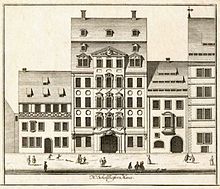Hotel de Saxe (Leipzig)
The Hôtel de Saxe was a hotel in downtown Leipzig from the 18th to the 20th century .
history
In 1711 (or 1717) a baroque town house was built on the current property at Klostergasse 9 for the Leipzig trading family Schellhafer (other source: for the merchant Nicolaus Zehe) . The property, which formerly belonged to the Augustinian Canons' Monastery, was in private ownership even before its secularization . B. 1529 to the mayor Wolf Wiedemann and was already built on. Both David Schatz and Christian Döring cite the baroque house as his work. Both were working in Leipzig at the time.
In 1776 the Martiussche Gasthaus, now located here, was given the right to call itself the Hôtel de Saxe. With its hall in particular, it played an essential role in Leipzig's musical life in the 18th and early 19th centuries. This is where the Collegium musicum , headed by the University Music Director Johann Gottlieb Görner , came together to compete with the Bach Collegium musicum. In the summer of 1787 Johann Adam Hiller organized a series of concerts at the Hôtel de Saxe; In 1791 the Royal Prussian Chamber Composer Carl Stamitz invited to a "musical academy". In the concert season 1809/10, the first public concerts of the Gewandhaus Quartet , founded in 1808, took place here.
It is not known whether Mozart stayed at the Hôtel de Saxe during his stay in Leipzig in 1789; his widow Constanze did it in 1796 and brought the score of the Requiem in D minor (KV 626) for the first performance in Leipzig under Johann Gottfriedschicht with her . Frédéric Chopin also stayed here on September 27, 1835. According to an information board on the successor building, Napoleon , Blücher , Goethe and Gneisenau are also said to have stayed here.
In the second half of the 19th century, the Hôtel de Saxe was an important meeting place for Leipzig. In 1859 it was bought by the participant in the Dresden May Uprising in 1848 and Ludwig Würkert subsequently condemned it . From 1861 to 1867 he ran his “Restoration for popular education, popular ennoblement and encouragement”, in which lectures were held every week. Emil Adolf Roßäßler and Alfred Brehm performed here, among others . From 1862 this was the seat of the Forward Association , from which the Leipzig Workers' Education Association emerged in 1865 under the leadership of August Bebel . Wilhelm Liebknecht and Karl Liebknecht , among others, frequented this place , and the Hôtel de Saxe was also reflected in the memories of August Bebel.
In 1909 the hotel was closed. But the name for the house remained.
In 1968 the building, which was badly damaged during the Second World War, was demolished due to its dilapidation. A new building was built at the same location from 1976 to 1978. An incomplete copy of the original baroque portal was added to the new building at a later date. In addition, a memorial plaque refers to the historical importance of the former hotel.
additional
Since 1994 there has been another hotel in the Gohlis district of Leipzig that bears the name Hotel de Saxe .
Individual evidence
- ^ Margin note on an engraving in the Leipzig City History Museum
- ↑ Leipzig music trail
- ^ Andreas W. Daum: Science popularization in the nineteenth century. P. 156.
literature
- Horst Riedel: Stadtlexikon Leipzig from A to Z . PRO LEIPZIG, Leipzig 2005, ISBN 3-936508-03-8 , p. 253.
- Wolfgang Hocquel: Leipzig. Architecture from the Romanesque to the present . Passage-Verlag, Leipzig 2001, ISBN 3-932900-54-5 , p. 66/67.
Coordinates: 51 ° 20 ′ 26.3 " N , 12 ° 22 ′ 22.7" E


